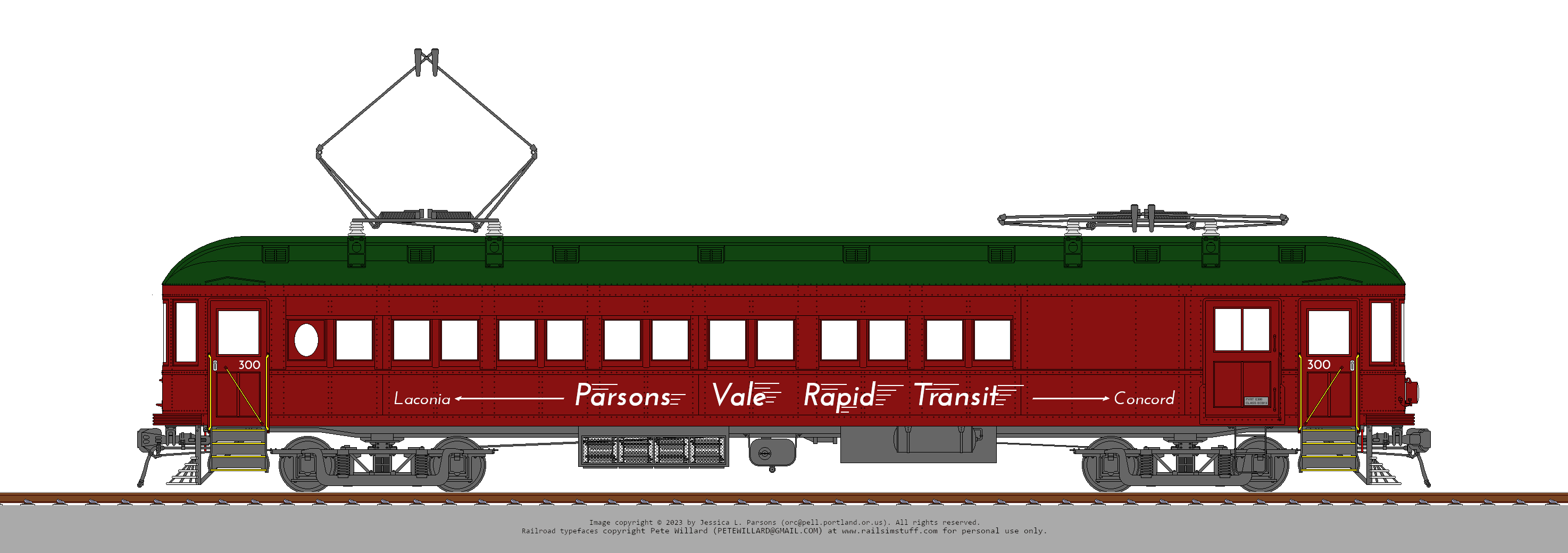For a brief moment at the start of the 1900s, it seemed believable that the town of Parsons Vale (population 1030) was poised on the brink of greatness. After all, the PV&T had connected the town to Portland and Montréal, and the Ace & Acme Lumber Company had just been purchased by the Lincoln & Concord Railway as part of its plan to connect Parsons Vale and the rich lumberlands at the foot of the White Mountains to its Lincoln to Concord mainline. With these signs of greatness, a proposal to connect Parsons Vale to Concord by a direct interurban railway seemed like a sure bet. So, in 1909, the Parsons Vale Rapid Transit Company was formed to build an electric interurban railroad from Parsons Vale to Concord. Construction started soon thereafter, and the line was completed in 1911 (with, in 1913, a freight branch to Lincoln and – an immensely profitable – branch from Winnisquam to Laconia.)
As all of the other railroads into Parsons Vale discovered, there was no gold to be made in passengers. But, unlike the unfortunate L&C, the PVRT survived by promoting holidaymaker service and online businesses on the Laconia branch, and traffic rights to the PV&T (the PV&T’s original line from Franklin to Plymouth was destroyed in a freshet in 1916, and it was cheaper to get trackage rights and pay the PVRT to convert their line from Franklin to Holderness from 600vdc to 1500vdc than it would have been to rebuild all of the washouts and other flood damange along their original ROW; this kept the line to Parsons Vale running through the Great Depression years), and settled into a comfortably profitable life.
When the LW&C was abandoned in 1936, the PRVT picked up three steeplecab motors, but otherwise didn’t change its initial locomotive roster until 1942, when it dealt with the rapid increases in traffic caused by the second world war by converting the Parsons Vale to Concord mainline from 1500VDC to 3000VDC (the PV&T’s 3kvdc motors could, of course, operate on 1500vdc, just at reduced speeds & power, so express trains were piloted by lashups of PVRT motors & express cars, which was an interesting sight.) After the conversion, all PV&T bridge traffic was carried behind PV&T motors while local traffic was carried behind engines 1018 and 980, which had been converted to 3000VDC.
The old 600vdc segments of the PVRT were slowly abandoned; the original side of the road alignment from Concord to Tilton went in 1936, and then in 1964 the line from Winnisquam to Lacona was abandoned after the Winnisquam bridge failed as a freight train pulled by motor 1018 was crossing it.
With the loss of the Laconia branch (the majority of the surviving shippers were on the south side of Paugus Bay, and they all switched to using trucks when service on the branch abruptly stopped) the railroad was down to 5 small shippers on the old Concord<->Parsons Vale mainline. This meant that the railroad was surviving exclusively on charging the PV&T for trackage rights on the line, and that was not enough to pay for 10 remaing employees (1 3-person operating crew, 1 person managing the railroad, a lawyer (on retainer), and 5 people in the track gang) and dividends to the stockholders. And this meant that when the PV&T proposed leasing the railroad outright it was almost embarrassing how quickly management said YES to that offer.
The PVRT is still – on paper – a separate corporation, but these days it mainly exists as a mailing address for the bank accounts that hold PV&T lease payments.
PVRT history
- 1911
- First Parsons Vale Rapid Transit train from Concord.
- 1913
- Franklin branch (Tilton to Franklin) opens.
- Laconia branch (Winnisquam to Laconia) opens.
- 1915
- Trackage rights between Franklin & Holderness granted to the PV&T after flooding destroys the PV&T’s old mainline between Franklin & Plymouth.
- 1936
- Engines 1040,1018,980 purchased from the PV&T.
- 1942
- Parsons Vale to Concord reelectrified at 3000VDC.
- PV&T starts running trains from Boston to Montréal via the PVRT.
- 1964
- Winnisquam bridge collapses, destroying 1018.
- Last passenger train (combination #300, passenger #999).
- Last shippers on the Laconia branch switch to trucks.
- 1965
- Laconia branch abandoned.
- Leased to PV&T for 999 years.
All-time PVRT Roster
| No. | Type | Builder | Acquired/Built | Disposition |
|---|---|---|---|---|
| 1-7 | Passenger motors | St Louis Car | 1910 | retired 1947 |
| 8 | Baggage motor | St Louis Car | 1910 | stored 1938, reactivated 1942, retired 1948 |
| 9 | Combination motor | St Louis Car | 1910 | renumbered to 300 & converted to 3000VDC 1947, to work motor 1964, stored 1966 |
| 10-12 | Boxcab | Baldwin | 1910 | retired 1947 |
| 13 | Rotary snowplow | AC&F | 1910 | to PV&T M1006 |
| 14 | caboose | Montreal Carriage | 1910 | wrecked 1964 |
| 15 | caboose | Montreal Carriage | 1910 | to PV&T 157C 1967, retired 1990 |
| 999 | Passenger motor | Brill | 1924 | stored 1964, to Connecticut Trolley Museum 1966 |
| 1040 | Steeplecab | Baldwin | 1937 | originally LW&C 40, converted to 3000VDC 1950, to Seashore Trolley Museum 1961 |
| 1018 | Steeplecab | Baldwin | 1937 | originally LW&C 41, wrecked 1964 |
| 980 | Steeplecab | Baldwin | 1937 | originally LW&C 42, converted to 3000VDC 1947, to PV&T 282, in service. |
| 633 | Boxcab | AC&F | 1936 | from Albany-Hudson Fast Line 30, stored 1948, to IRM 1977 |
